Pailton Leatherlands

An attractive house in Pailton
Pailton, Monks Kirby and Stretton under Fosse are three adjoining villages in Warwickshire. My Leatherland family line probably moved to Pailton in the 1820s.
SAMUEL LEATHERLAND (1791 – 1880)
In the 1851, 1861 and 1871 census Samuel was consistent in telling the enumerator that he was born in Kilsby. For a long time I could never find his baptism in the parish registers, the bishops transcripts, nor the Kilsby Independent (Congregational) chapel register.
Then one day I noticed an entry I had missed. On Christmas Day 1790 Samuel son of William & Ann LEALON was baptised. Lealon is a very rare surname but my theory is that this is Samuel Leatherland and that Lealon is a rare variant. There was no further trace of Samuel Lealon.
We know little about Samuel’s early life, but his mother died when he was ten and his father remarried and had nine more children, so it was probably a crowded household.
Samuel married Elizabeth Langton in Claybrook, Leicestershire in 1818. The parish register said that Samuel came from Monks Kirby. In the censuses Elizabeth said she was born in Ravensthorpe, Northants in about 1794 although I have not found her baptism (see Langtons of Teeton/Ravensthorpe).
Although Claybrook is in Leicestershire, it's only five miles north of Pailton and I expect that Elizabeth was working there.
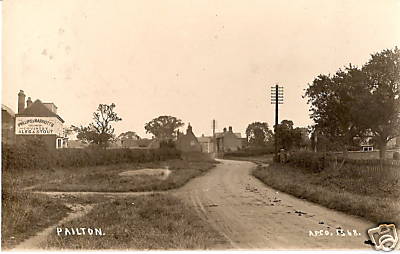
Samuel and Elizabeth had nine children. One died in infancy. None of their children's baptisms have been traced either in the Monks Kirby registers or elsewhere. The surviving children were : Mary (1821), Elizabeth (1823), Sarah (1826) , Ann (1827), Emma (1830), John (1831), Hannah (1835) and Samuel (1835). I find it odd that their baptisms have not been found, but in censuses they all stated they were born in Pailton which indicates that they were brought up there.
There is other evidence of the family's presence in Pailton in the 1820s. Elizbeth Leatherland witnessed a baptism in 1822. And the Monks Kirby school records show several of their children attending that school.
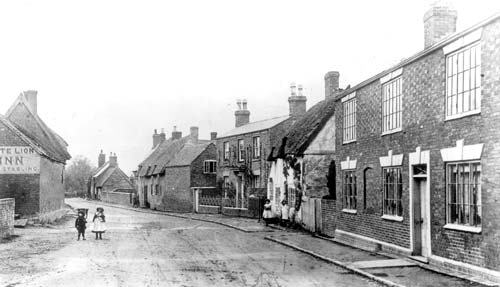
Coventry Road, Pailton in the 1900s
(Image produced from the Windows on Warwickshire service http://www.windowsonwarwickshire.org.uk with permission of Landmark Information Group Ltd. www.landmark-information.co.uk and Ordnance Survey www.ordnancesurvey.co.uk )
The 1841 census shows Samuel and Elizabeth Letherland living in Pailton. Samuel was a 45 year old agricultural labourer, Elizabeth was 35. Ages were rounded down to the nearest five years in the 1841 census, so Samuel was really between 45 and 49. Their daughter, Sarah, was living in Monks Kirby half a mile away but in a separate household at Monks Kirby Lodge with a farming family.
In the 1851 census, the parents remained in Pailton. Samuel was now 60, Elizabeth 57. This enables us to pinpoint his birth to around 1791. Their grandson, William (Sarah's son) was living with them. Sarah was not with her son or parents - she was living in Coventry in the household of Charles Sabin, an innkeeper, and unmarried (William had no father named on his birth certificate). So it seems that Samuel and Elizabeth were looking after or bringing him up their grandson.
In 1861 Samuel and Elizabeth were still in Pailton with their son, John, now a 29 year old railway labourer ; their granddaughter, Hannah Leatherland, aged ll ; and their grandson, John Warpole, aged 8. Hannah is a bit of a mystery, but she may be the girl whose birth was registered as Harriet, daughter of Emma Leatherland in 1849 in Brinklow, a village two miles away. Emma married Francis Walpole in 1852 and John Warpole was their son.
In the 1871 census Samuel was 80 and Elizabeth 76. They were living in Coventry Road, Pailton, with their forty year old son John who was still unmarried. Elizabeth died of senile decay in a lunatic asylum eight years later. Samuel died the following year at the grand old age of ninety.
SAMUEL AND ELIZABETH LEATHERLAND's CHILDREN
Mary Leatherland was born in about 1821. I have not found her baptism nor was she was with her parents in 1841 but several pieces of evidence show that she is Samuel and Elizabeth’s daughter : her marriage certificate names Samuel as her father, she lived in the Stretton-under-Fosse / Monks Kirby area in 1841 / 1851 / 1861, and she was informant on the death certificate of her sister Sarah's infant son.
Mary married James Jones in Monks Kirby in 1840. Her occupation was servant on the certificate, the same was true of James. They had five children. James died in the 1850s. By 1861 Mary was living in Monks Kirby with her brother-in-law Simeon Salisbury and his family. I have not managed to trace Mary beyond 1861.
Elizabeth Leatherland was born in about 1823 in Brinklow. In 1841 she was a farm servant in Brocklehurst, Monks Kirby with the Foster family. When she was 18 she has an illegitimate child who only survived for a few months. She married John Smith in 1847 in Brinklow. In 1861 she was still living in Monks Kirby and now had a four year old daughter, Elizabeth. I have not traced her beyond then.
Sarah Leatherland was born about 1826. In 1841 she was a 15 year old farm servant in Monks Kirby Lodge living with a farming family. In 1845 she had an illegitimate son, William, born in Pailton. She went on to have two more children in the early 1850s but both died in infancy. In 1851 Sarah was a 26 year old cook living in Smithfield Street, Coventry in the household of Charles Sabin, an innkeeper. There were a large number of visitors in the household so it was probably a hotel. By 1861 Sarah had moved to Birmingham. She was a domestic cook in the household of Emily Bartlett. In 1863 she married Henry Palmer, a soldier in the Royal Artillery, in Birmingham. By 1871 they had moved to Northampton where Henry was a refreshment house keeper. I have not managed to trace her beyond that time.
Ann Leatherland was born in about 1826. In 1841 she was 15 years old living in Pailton with her parents. In 1850 she married Simeon Salisbury, a labourer from the neighbouring village of Stretton–under–Fosse. In 1851 they lived in Brinklow. They had three children during the 1850s but Ann died at the age of 30. Simeon went on to remarry Sarah Thompson and they had a son. They continued to live in Stretton-under-Fosse.
Emma Leatherland was born around 1830.At the age of 17 she had an illegitimate daughter, Harriet, born in Brinklow. In 1851 she was a house servant in Willey, Warks in the household of Nicholas Wallin, a farmer. The following year she married Francis Warpole/Walpole. They had a son John who later became a railway fireman in Rugby. Francis died probably a few years after their marriage. In the 1861 census Emma seems to have reverted to her maiden name indeed she told the census enumerator she was unmarried. She crops up in Derby in 1861 as a house servant in a large household, a cook in 1871 at Natchbury Hall, Barford, Warks in household of William Wallis, and a domestic cook at the Crewe Arms Hotel, Crewe in 1881. By 1881 she was describing herself as a widow. By 1883 Emma married John Davenport in the chapel of Newnham Paddox, a manor house owned by the Earl of Denbigh in Monks Kirby. She died in 1896 in Monks Kirby.
John Leatherland was born around 1831. He worked as a railway labourer in his early years. The censuses suggest that he lived with his parents until he was in his 40s when he married a widower who already had two children. He went on to have four more children of his own, but only one survived into adulthood. One boy Ernest John died aged 12, and a daughter Ada Emma died when she was 10 years old. His son Samuel Willie went on to became a crane driver, married and had two daughters.
In his later years John worked as a carrier - a man who carried goods by horse and cart. His life ended rather tragically. He died in a pit at Carter`s Farm, Pailton at the age of 82 having suffered "asphyxia caused by drowning having committed suicide while temporary insane". There was an inquest held by the North Warwickshire Coronor and I examined the coroner's records held by the Warwickshire County Record Office in Warwick. The Coroner's case files from 1913 include a brief file on John Leatherland. A standard inquisition form shows that the coroner and a jury of twelve came to the verdict that John drowned. The records consisted of two poingant statements, one from his daughter-in-law Jane Leatherland, the other from a neighbour, Rebecca Clarke. Here are the statements :
Evidence of Jane Leatherland, Pailton, Rugby 21 April 1913 : 'Jane Leatherland Pailton (daughter-in-law of the deceased) states I identify the body of that of my father-in-law John Leatherland age 82 he has been in ill-health for some time past, latterly getting worse, I have been nursing him and his invalid wife, on 19th April he gave me his money and told me to take care of it for him until he wanted it, he afterwards commenced to put on his boots, I was surprised at this as he had never been out of the house for a fortnight & I asked him what he was putting his boots on for & he said I am going out to get a breathe of fresh air as I feel very ill & I think it will do me good he then put on his hat, took his walking stick & went off in the direction of the pit where his dead body was afterwards found I started to follow him & he turned round & said something but I could not say what it was. Mrs Clarke then followed him across the field.'
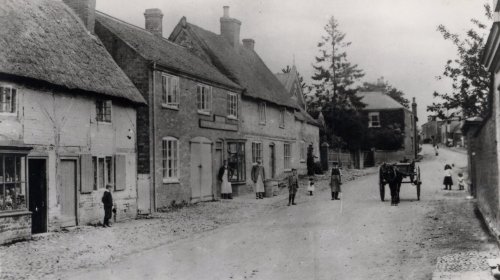
Lutterworth Road, Pailton c 1900
Evidence of Rebecca Clarke, Pailton, Rugby 21 April 1913 : 'Rebecca Clarke wife of John Clarke Pailton states I am a neighbour of the deceased & have known & respected him for a long time on 19th April I saw him going in the direction of Carter's fields in consequence of what I heard from his daughter in law about his money and knowing that he was ill and had not been out of the house for a fortnight my suspicions were aroused & I followed him keeping some distance behind him he went along Carter's field occasionally turning round apparently to see if anyone was following him after turning round the last time he suddenly disappeared I knew there was a pit close by & I ran as fast as I could to it when I got there I found his hat & walking stick laying on the side of the pit & his body laying head first face downwards in the water bubbles were proceeding from the mouth I ran straight into the mud & water & caught hold of the deceased's coat & succeeded in drawing him to the side he was then apparently dead I could not get him any further but my husband and another man came up & pulled him on to the bank Dr Johnson was called & arrived very quickly but pronounced life extinct. From the time the deceased disappeared until I got him to the side would not be above 3 minutes & I feel now he was then quite dead.'
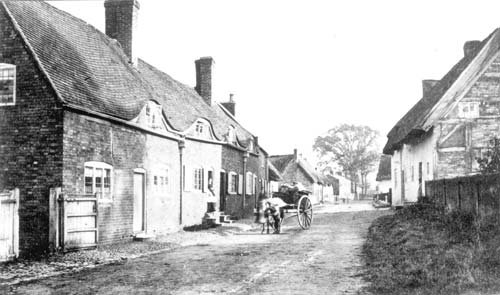
Horse and cart in Coventry Road, Pailton 1890s
(Image produced from the Windows on Warwickshire service www.windowsonwarwickshire.org.ukwith permission of Landmark Information Group Ltd. www.landmark-information.co.uk and Ordnance Survey www.ordnancesurvey.co.uk )
Hannah Leatherland was born around 1835. In 1851 she was a 17 year old unmarried domestic servant in the household of John Adrian a licensed victualler in Coventry. In 1859 she witnessed the marriage of a Henry Lenton a gardener to Elizabeth Thornton in Coventry. Hannah worked as a domestic servant in Coventry and lived with the Dalman / Dolman family who were hairdressers and probably her employers for over 30 years. By 1901 Hannah was 66 a lodger living on her own means in Coventry in the household of Elizabeth Mayfield, a silk warper. She died at Brockhurst, Monks Kirby in 1905. The death certificate described her as a general servant (domestic) daughter of Samuel Leatherland (farm labourer).
Hannah is the only member of the Pailton Leatherlands to have made a Will in 1905. She appointed Edward Colban (a schoolmaster) of Brockhurst as executor, and left her estate equally to her brother John, her brother Samuel, her nephew William Leatherland, and nephew Joshua Walpole. The net value of the estate was £277. I suspect that she inherited money or property from the Dalmans although I have no evidence to support this. Hannah's will was the key piece of evidence connecting the Pailton Leatherlands to the Churchover ones becauase it proved that brother Samuel was descended from the Pailton branch.
Samuel Leatherland was born around 1835. There is a possible baptism in 1835 in Churchover son of Samuel and Elizabeth of Kilsby, but this may not be right and it is likely that Samuel was baptised along with his brother and sisters in a location which has not yet indexed.
In 1851 Samuel was 15 a farm servant in Monks Kirby. A farm servant was a farm worker who lived with the farmer’s family. By 1861 census he was a shepherd, in Farm Town, Coleorton, Leicestershire. In 1866 he married Susanna Foster from Churchover. They settled in Churchover and had thirteen children. He died aged 75 and a headstone marks his burial in the churchyard.
You can read more about Samuel and his children in Churchover Leatherlands.
Some of Samuel's Grandchildren
Samuel’s grandson Samuel Willie Leatherland became a farm labourer and married Jane Wood in 1909. He later became a crane driver.
Another grandson, William Leatherland, was born in 1845 in Pailton. In 1851 when he was 5 years old he was staying with his grandparents. In 1861 he was a 15 year old plough boy living in Heath, Churchover in the household of farmer James Lee and their two daughters, as a boarder. William later became a servant, shop assistant, and then a provision dealer /grocer working in the centre of Birmingham.
William's children are interesting. He had three sons : Charles Benton, William and Bertie Alfred. Two of them became stage acrobats. You can read more about them in "Leatherland Family Biographies".
Other Pailton Leatherlands
William Leitherland married Ann Gill in Monks Kirby in 1818. They had a daughter, Mary, in 1818 baptised in Harborough Magna, a neighbouring village. The baptism entry said William was a servant from Easenhall. William died in 1839 in Stretton-under-Fosse at the age of 61. Ann remarried in 1841. The 1841 census shows a 7 year old child, William Leithland, living with her and her new husband. He is presumably her son. But how do they all fit in with Samuel and Elizabeth ? William could be Samuel's brother although there is no direct evidence of this. William could also be the child baptised in Welford in 1780, son of William and Ann Leatherland.
Pailton Village
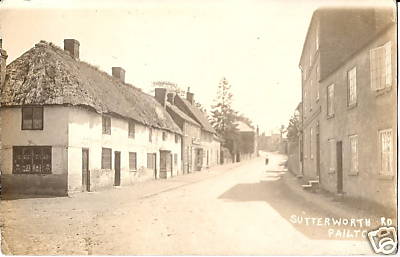
Lutterworth Road, Pailton in an old postcard scene of Pailton
The Pailton village website www.pailton.org.uk is well worth a visit and my brief village history is based partly on this, but also on a book called '1756 Acres : A History of the People of Pailton, Warwickshire' by Roy Bourne (1984). Roy Bourne's book is a fantastically detailed history of Pailton from the 18th century to the mid 20th century, looking at a number of topics, including land enclosure, the Pailton Riot of 1836, some prominent Pailton families and benefactors, Pailton's churches and schools, commercial Pailton, socities and clubs, local government, and agriculture.
Pailton is a Saxon name meaning "homestead" or enclosure surrounding a farm. In 1554 an Act of Parliament changed the use of Pailton Pastures from arable land to sheep pasture. The King owned the Rectory and Patronage of Monks Kirby but Henry VIII gave them to the newly created Trinity College, Cambridge. This included Pailton Pastures and the tithes from the farms of Pailton .
The Enclosure Act of 1761 led to the enclosure of three of the open fields of Pailton. Over the next century enclosure and tithes caused many disputes in the area between smaller land occupiers, both Trinity College and a local lord of the manor, the Earl of Denbigh. The location of many Pailton farms and consequent housing were often shaped by these dispute.
The opening up of Pailton with the building of the turnpike roads sparked an expansion of commercial facilities and the village became a thriving community from the 18th century with wheelwrights, blacksmiths grocers, butchers and bakers, tailors and shoemakers, millers, millwrights and timber merchants, building and metal trades. Pailton had good road links and transport businesses developed of both people and goods, starting with horse drawn vehicles and progressing into successful coach and lorry firms. This is illustrated by the fact that one of the Leatherlands who lived in Pailton, John Leatherland (1831-1913) worked as a carrier in his later years - a carrier carried goods and people by horse and cart. Over the years there were many pubs and inns in Pailton : the Bell, the Saddlers Arms, the Three Hats, the Fox, the Plough and the White Lion. The White Lion is the only one remaining. It is a hotel as well as a pub and the building has 17th century origins. Monks Kirby Pailton is actually in the parish of Monks Kirby, Monks Kirby being the largest of the three villages. A Benedictine Priory was built there in 1077 which gave the parish its name. It is the largest parish in north east Warwickshire.
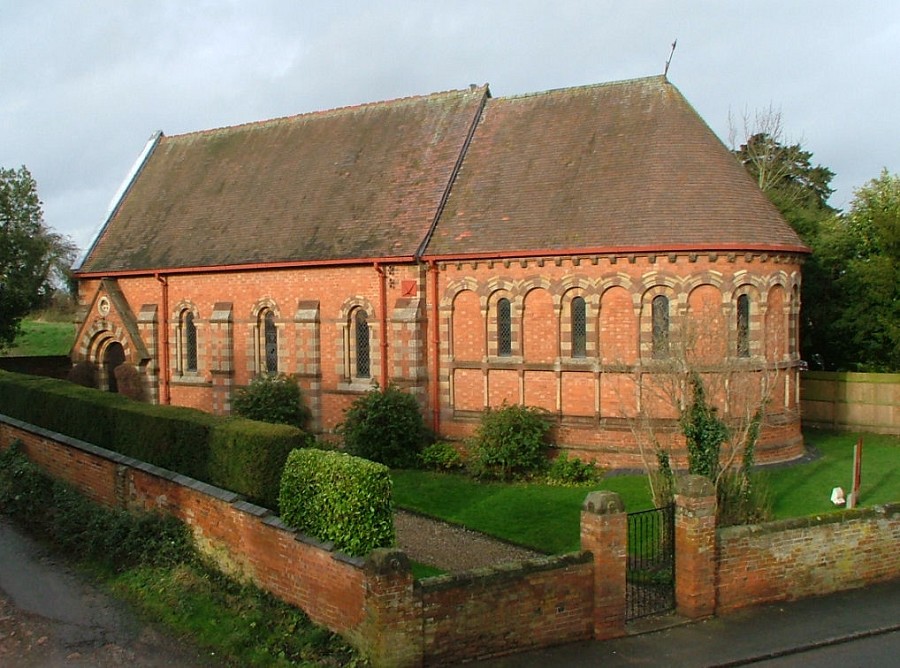
St Denys in Pailton built in the late 19th century [photo courtesy of the Revel Group of Parishes website]
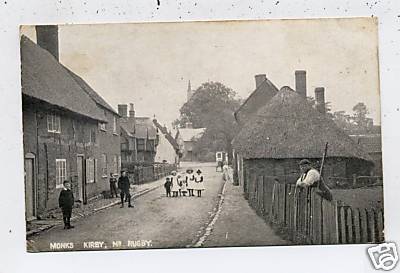
The parish church of St Edith is enormous in comparison to the size of the village. You can see the tower of the church dominating the view from Pailton one and a half miles away. The church was rebuilt in the fourteenth century and extended in the fifteenth. The stately home of Newnham Paddox is nearby, seat of the Earls of Denbigh from the fifteenth century to 1952.
Stretton-under-Fosse
Stretton-under-Fosse is one and a half miles from Pailton. The village has an helpful website found under www.surfvillage.co.uk/content/index.asp which I have used in this brief description. The village straddles either side of the Lutterworth to Coventry Road. The Oxford Canal runs a mile from the village and the M6 motorway is nearby. Stretton is very small with only about 70 houses. Many old farm houses, cottages and barns have been attractively restored. Oddly perhaps there is no village church. However there was an independent chapel.

Stretton-under-Fosse (Photo©David Richards)
According to the village website, until fairly recently there were two working farms , a pub - the Union Jack - and a small shop. These have all now gone but the village has a Malt Kiln Farm Shop with a plant and specialist food centre and coffee shop. There are some small businesses by the canal at The Wharf, including Rose Narrowboats boat building and holiday boat hire. There is a small Village Hall. Like Pailton and Monks Kirby the village is still surrounded by farmland, mostly arable but with some livestock : cows and sheep. Stretton also has attractive light woods criss-crossed by a network of footpaths.
Near Stretton-under-Fosse is the entrance to Newbold Revel, the ancestral home of the Skipworth family. Before they rebuilt the house in 1716, it was owned by Sir Thomas Malory, a Knight in the Wars of the Roses, who translated the medieval legend of Morte d'Arthur into English. The building was later used by St. Paul's Training College for Teachers. It is now a Prison Officer Training College.